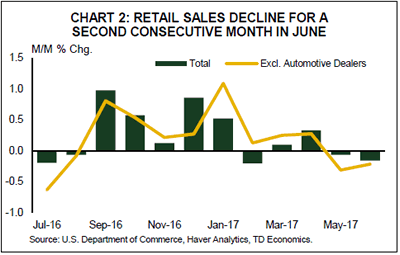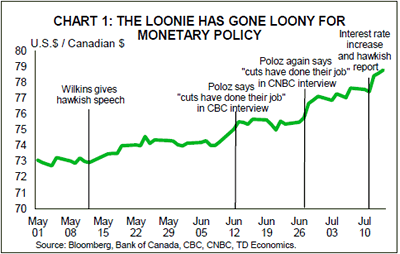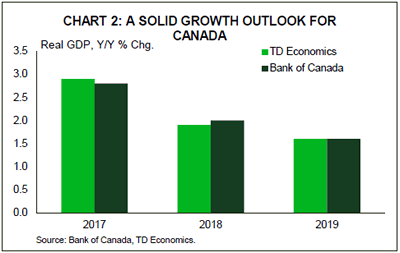U.S. Highlights
- Fedspeak took center stage this week. Fed Chair Yellen delivered prepared remarks to Congress, where among other things, she acknowledged the uncertainty as to when inflation would rise back toward its target.
- Taken together with Governor Brainard’s comments, markets interpreted the tone as dovish, with long-term Treasury yields and U.S. dollar falling, while U.S. equities soared toward all-time highs.
- Both the CPI and retail sales reports came in below consensus, adding further downside risk to the pace of Fed hikes over the next year and a half.
Canadian Highlights
- The Canadian dollar gained more than a cent vis-à-vis its U.S. counterpart since mid-week as the Bank of Canada hiked interest rates for the first time since 2010 and indicated that more increases are likely in store.
- Hawkish statements and a solid economic outlook both suggest that another policy rate increase is coming soon – most likely in October. A more gradual pace of hikes is expected thereafter.
- Governor Poloz noted that the path forward will be ‘data dependent’, but with inflation forecast to remain soft through the remainder of this year, the pace of future hikes will likely hinge on the continued rotation of economic growth. Non-commodity investment and exports are the indicators to watch most closely.

U.S. – Soft Inflation Risks Delaying Fed Hike
Fedspeak took center stage this week with six members of the FOMC making public appearances. In what may be her last Congressional testimony as Fed Chair, Janet Yellen delivered prepared remarks and answered questions in both the House and Senate this week. She reiterated the Fed’s narrative that the economy is healthy enough to withstand further rate increases and that the process of balance sheet reduction is expected to begin this year. That said, she did acknowledge the uncertainty as to when inflation would rise back toward its target, noting that a handful of past factors would pressure inflation down until they drop out of the annual calculation. Inflation numbers out this morning confirmed that price pressures remained subdued in June, with the softness casting some doubt as to the idiosyncratic nature of the recent loss in momentum (Chart 1).
The Chair elaborated on the neutral rate of interest, noting that it is currently low, necessitating patience as far as rate hikes. However, she suggested that the neutral rate would likely move higher towards the 3% mark as the temporary factors holding it down ease off, motivating additional rate hikes over the coming years. This marked a divergence from Governor Brainard, who suggested in her remarks this week that the neutral rate is "likely to remain close to zero in real terms over the medium term." Taken together, markets interpreted the comments as dovish, with long-term Treasury yields and U.S. dollar falling, while U.S. equities soared toward all-time highs. The latter were also buoyed by rising oil prices, on account of a bullish U.S. inventory report.
Yields and the dollar were further weighed down by a soft retail spending report with sales retreating in June, falling short of expectations for a modest gain (Chart 2). While the softer print leaves our second quarter consumption estimate still near 3%, the story is less upbeat as far as momentum heading into the third quarter with consumption on track to decelerate closer to the mid-2% mark. Together with the relatively broad-based weakness in discretionary spending categories, the poor spending performance leaves us somewhat puzzled – particularly given the continued strength in the labor market. On the whole, the combination of the weak CPI and retail sales reports adds some downside risk to the pace of Fed hikes over the rest of the next year and a half.
Still, we expect inflation pressures will begin to build through the remainder of the year, helped by an increasingly tight labor market. The labor market strength was reaffirmed by secondary data releases this week, with the JOLTS report indicating improved hiring and quit levels – the latter reflecting worker confidence – and upbeat worker compensation plans among small businesses in the NFIB survey. That said, the process of firming inflationary pressures is proving slower than expected.
Outside of the U.S., improving global growth appears to be emboldening other central banks to consider reducing stimulus. The Bank of Canada saw through soft inflation figures and raised its overnight lending rate this week for the first time in 7 years. Meanwhile, tightening talk has gained further traction at the Bank of England, and the European Central Bank looks to announce a taper schedule of its asset purchases later this year. Such convergence in monetary policy direction would help the Fed’s interest rate normalization plans, but for now all eyes remain firmly on inflation.


Canada – Where to From Here?
Market moves this past week were dominated by the Bank of Canada’s decision to hike its key policy interest rate by 25 basis points to 0.75% on Wednesday. The increase was largely expected by markets, but the hawkish tone of the statement and press-conference pushed the loonie up by more than a cent in anticipation of a faster pace of future rate hikes (Chart 1). Further supporting the Canadian dollar were soft U.S. data and higher oil prices, which rose by more than $2 U.S. per barrel as of Friday morning.
If there was a ‘missing piece’ going into Wednesday’s monetary policy decision, it was inflation – which has been trending lower in recent months. This softness was attributed by the Bank of Canada to special factors such as electricity rebates. But, ‘core’ inflation measures, designed to provide a picture of the trend excluding such idiosyncratic factors, also weakened. Regardless, this was a departure from earlier communication that had suggested inflation was being held back by past economic shocks and should thus be near a turning point.
Regardless of what is driving current inflation, it is increasingly clear that the Bank of Canada will look through it. Governor Poloz likened relying on current inflation to guide monetary policy as "driving using only the rear-view mirror". Extending this metaphor further, we would argue that monetary policy ‘driving’ more resembles using a video game (or simulation), as his decisions rely on what models suggest inflation will do. While the economic backdrop generally supports gradual monetary tightening, there nevertheless would have been little harm in waiting slightly to begin increasing rates, were it not for the aggressive communication strategy to prep markets for Wednesday’s decision.
Indeed, with another robust quarter of economic growth looking increasingly likely, and a broadening of growth drivers, emergency-level interest rates are no longer needed. In fact, the current tracking suggests that 2017 growth is likely to slightly outpace the Bank of Canada’s upgraded forecasts (Chart 2). This suggests that the path forward is likely paved with further interest rate increases.
The key questions are therefore: how aggressive will the Bank of Canada be in removing monetary stimulus; and what factors could delay further interest rate increases? Given the healthy near-term growth outlook, the Bank will seek to remove the remainder of the 2015 policy rate cuts later this year, likely at its October meeting. Once that is accomplished, a more gradual pace is likely. We expect one 25 basis point hike every six months or so, aiming to balance support for an ongoing growth rotation while containing inflationary pressures.
Governor Poloz focused on ‘data dependency’ as guiding the path forward. The Bank of Canada is forecasting further deceleration in inflation in the near term. Making inflation unlikely to have much bearing on Poloz’s thinking over the coming quarters, unless the deceleration is severe. More important will be the evolution of non-commodity business investment and export dynamics going forward. These will serve as important bellwethers for the durability of Canadian economic growth and any sustained weakness in these categories will likely give the Bank of Canada cause for concern.


Canada: Upcoming Key Economic Releases
Canadian Manufacturing Sales – May
Release Date: July 19, 2017
April Result: 1.1% m/m
TD Forecast: 1.0% m/m
Consensus: 0.7% m/m
The manufacturing renaissance underpinning the recovery in the goods sector is expected to continue into May with a forecasted 1.0% m/m increase in manufacturing sales. Underpinning our forecast is a strong rebound in motor vehicle shipments after a 3.7% decline last month, presaged by a sharp rise in auto exports while a further improvement in metal/mineral products should add to the headline strength. However, there are a few offsetting factors to consider – we expect a sizeable contraction in wood product shipments following the new softwood lumber tariffs and gasoline sales will be negatively impacted by falling prices at the pump. Due to an offsetting increase in core producer prices, we would look for volumes to be in line with the nominal print, which would leave real manufacturing sales growth at its strongest level since late 2014 on a year-ago basis.

Canadian Consumer Price Index – June
Release Date: July 21, 2017
Previous Result: 0.1% m/m
TD Forecast: 0.0% m/m
Consensus: 0.0% m/m
We look for June headline inflation to slip further to 1.1% y/y vs 1.3% y/y in May, reflecting unchanged prices on the month. The lift from energy prices on a year-ago basis is expected to turn to a drag, led by lower gasoline prices, while food price deflation should dissipate in line with rising agricultural prices. We expect continued strength in shelter costs as presaged by the ongoing acceleration in the new housing price index, while falling vehicle prices remains a downside risk. We look for more signs of stabilization in the core metrics of inflation (CPI common, trimmed mean and median), which averaged a cycle low of 1.3% y/y in May. However, a continued downward pull from lagged effects of slack cannot be ruled out.

Canadian Retail Sales – May
Release Date: July 21, 2017
April Result: 0.8% m/m; ex-auto: 1.5% m/m
TD Forecast: 0.3% m/m, ex-auto: -0.1%
Consensus: 0.4% m/m, ex-auto: 0.4%
Retail sales are forecast to advance by a moderate 0.3% m/m in May, led by a further pickup in motor vehicle sales. In contrast to the United States, we have yet to see any plateau in Canadian auto sales thus far in 2017 and there are indications that May might have been another record setting month. This will help to offset a sizeable drag from lower gasoline prices and housing related purchases and will leave ex-auto sales 0.1% lower on the month, though volumes should outperform the nominal print. Existing home sales in the Toronto region fell by roughly 25% in May following the introduction of new macroprudential regulations, which should constrain demand for furniture and other household furnishings. Elsewhere, we look for continued labour market gains (full time employment rose by 77k during the month) to support household spending in the near-term before the combination of higher interest rates and a more tepid housing outlook introduce a healthy cooling to the retail sector over the second half of the year.













